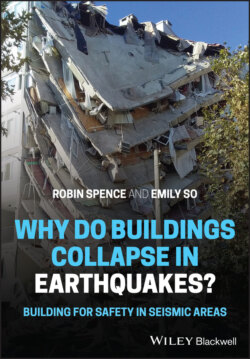Читать книгу Why do buildings collapse in earthquakes? Building for safety in seismic areas - Robin Spence - Страница 24
2.2.8 The 22.2.2011 Christchurch New Zealand Earthquake: Mw6.1, 181 Deaths
ОглавлениеThe earthquake occurred at 12.51 p.m. local time, causing severe shaking throughout the City of Christchurch, the largest city in New Zealand's South Island. The Mw6.1 earthquake was an aftershock of the Mw7.1 Darfield earthquake which took place five months earlier, and had also caused shaking and damage in Christchurch, but the epicentre of the 22 February 2011 event was much closer to the city, and caused ground shaking well in excess of the design level which the New Zealand Code specifies for Christchurch (EEFIT 2011a). The ground shaking destroyed hundreds of buildings in the city, including many old URM structures as well as two large office buildings, and 181 people were killed, nearly three quarters of them in the two collapsed office buildings. The earthquake also caused extensive liquefaction of soft alluvial ground both in the Central Business District and the eastern suburbs which added to the extent of building damage. The estimated total losses were US$15bn, of which around 80% was insured (King et al. 2014).
For more than a century, most residential buildings in New Zealand have been timber‐framed buildings with lightweight roofs and cladding, and most of these buildings survived the earthquake with little damage except to masonry chimneys and wall claddings (EEFIT 2011a). However, in liquefaction‐affected areas, the foundations of many residential buildings failed, resulting in their subsequent demolition. Many RC buildings in the Central Business District were seriously damaged, which was to be expected, given the high level of ground shaking. This shaking damage was combined with foundation damage caused by liquefaction, and many of the damaged buildings were subsequently demolished. The two major office buildings which collapsed were both built to pre‐1976 design requirements. The most widespread damage was to URM buildings, which comprised the historic core of Christchurch, including its cathedral, built in the 1870s to a design by Sir George Gilbert Scott, where the spire collapsed. All the masonry buildings in Christchurch had been built before the 1930s, and the materials used, the structural arrangements and the wall‐to‐wall and floor connections were inadequate for this level of shaking (EEFIT 2011a). There was widespread failure, mostly through overturning of poorly connected walls and gables (Figure 2.14), some of which killed and injured pedestrians.
New Zealand has had programmes of strengthening URM buildings since 1968 (see Chapter 8), and there were a significant number of URM buildings in Christchurch which had been retrofitted. In general, these performed better than the non‐retrofitted buildings, but many of these too were damaged, and have had to be demolished. By 2013, more than 90% of the non‐retrofitted URM buildings, and over 70% of the retrofitted URM buildings in the Central Business District (CBD) had been demolished (Moon et al. 2014). The earthquake was therefore an important test for the efficacy of previously used retrofitting techniques.
Detailed damage assessment of all the structures in the affected area was carried out by engineering teams in the weeks following the earthquake, for assessing occupant safety (Galloway et al. 2014). Thus, aerial imagery, although available, was not needed for damage assessment as it was in Haiti. The crowdsourcing approach to damage assessment using remote sensing pioneered in the Haiti earthquake (Ghosh et al. 2011) was, however, able to be tested in this event by the authors' team against extensive ground‐truthing (Foulser‐Piggott et al. 2015). This study confirmed that the aerial image‐based damage identification rates are quite low. For example, for masonry buildings in the CBD, only 56% of those buildings given a red (‘unsafe’) or yellow (‘restricted‐use’) tag by the ground inspection teams were identified as damaged from the remote‐sensing imagery.
Figure 2.14 Typical damage to pre‐1930s masonry buildings in Christchurch.
Many important lessons have been learned from this well‐studied event, about building performance, retrofitting, insurance, damage assessment and recovery procedures, as well as the limitations of life‐safety‐based codes of practice. These lessons are now beginning to be implemented, not just in New Zealand, but worldwide (Chapter 8).
